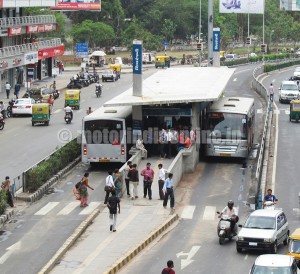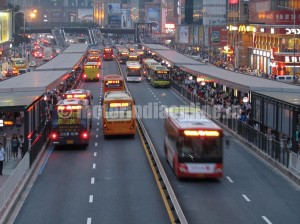Bus Rapid Transit (BRT) offers an innovative, flexible and high-standard solution for cost-effective transport and sustained urban development
Urban transport chaos is the order of the day in Indian towns and cities, and with over 18 million vehicles of different categories getting added on every year, the situation is worsening day by day. Gradual reduction in roadways due to encroachment and haphazard parking has made traffic management really tough. Sensing the unfolding worrisome scenario, many States have taken up different mass rapid transit solutions to alleviate the problem and restore the free flowing traffic. While metro rail, commonly referred to as the metro, has been one of the popular solutions sought, the other equally effective or even better option, the bus rapid transit (BRT), is also being seriously considered by city planners.
BRT should have been the logical choice against other solutions even earlier, particularly considering the lower capital costs involved, high quality of infrastructure and faster implementation. To get details of BRT basics, its advantages, its relevance for Indian cities and the integration with other transport systems, we met Mr. Christopher Kost, Technical Director, Institute for Transportation and Development Policy (ITDP). Read on for the world expert’s interesting insights and thought-provoking suggestions on the subject.
ITDP is a non-profit organisation with a mission to promote sustainable and equitable transportation all over the world. The environmental benefits and the cost effectiveness of the transport solutions offered make ITDP endeavours all the more appealing in today’s context. Its functional spread covers public transport, transit-oriented development, walking and cycling, traffic reduction, sustainable transport policy, as well as outreach and awareness.

Describing the genesis and operations of ITDP, Mr. Kost says: “We are a 30-year-old global organisation headquartered in New York that gives give pro bono advisory support to various levels of government. We help catalyse projects, review transport system designs and build the capacity of implementing bodies. Initially, we focused on the policies of multilateral agencies such as the World Bank with the idea of changing their mindset towards funding sustainable transport. Until then, banks largely funded projects promoting private automobile usage. In the mid-1990s we expanded our field of operation and began focusing on implementation of sustainable transport projects, with the goal of building one good BRT on every continent to serve as a model in that region.”
He adds: “ITDP’s foray into India began in the late 1990s through the cycle rickshaw design improvement and modernisation program in Delhi, Agra and Jaipur. Subsequently we began working on BRT and other functional areas. Our India head office is in Chennai, with other offices in Pune and Ranchi. Ms. Shreya Gadepalli, Regional Director, South Asia, is in charge of India operations.”
Origin and development
BRT had its humble beginning in the early 1970s at Curitiba, Brazil, and since then it has been operating in several cities of South America and a few other countries as well. The real tipping point came in the late 1990s with the opening of TransMilenio in the Colombian capital of Bogotá. TransMilenio is really comparable with some of the world’s largest metro systems in terms of passenger volume, comfort and other parameters.
Remarks Mr. Kost: “The system can carry about 45,000 passengers per hour per direction. It looks and feels like a metro, and in fact there are only a few metro systems that have a higher passenger handling capacity than Bogota’s BRT. This project, which was completed in three years, caters to a population of nearly 80 lakhs. The BRT success led to a paradigm shift in transport planning, demonstrating that it can rival the performance of even rail-based systems, that too at a much lower cost. Today we have successful BRT systems in many countries, including Brazil, Colombia, the US, Mexico, South Africa, Indonesia, China and India.”
What are the salient features of BRT and the unique selling points that score over other mass rapid transit systems? Mr. Kost explains: “The basic elements that are critical in any BRT include exclusive median lanes for buses to guarantee competitive speeds, off-board fare collection with electronic smart cards, platform-level boarding to make the system accessible to all users, and inter-section treatments that reduce delays. Besides, there are other commendable features like station design and bus-station interface, service planning, infrastructure, quality of service and passenger information system.”
Mr. Kost further observes: “BRT is a high capacity system that can handle the kind of passenger volumes that are prevalent in most corridors of Indian cities. Even with regular buses in a single lane, BRT can carry 5,000 passengers per hour per direction, and with articulated buses this can go up to 10,000. By using bi-articulated vehicles, the passenger carrying capacity can be well above that figure.”
“Comparing BRT with metro, the initial investment costs can be as low as 5-10 per cent. BRT systems can also be implemented in three years as against about 8-10 years for metro. BRT is also more flexible than metro, since buses can travel well beyond the dedicated corridors as part of the so-called “direct services” and eliminate the need for transfers. As for environmental impact, a study by a research organisation has found that Jaipur Metro would have much higher emissions than the BRT system. “Metro can be effective in certain corridors where passenger densities are very high. Yet such corridors are few and far between in the Indian context. In most cities, we need economical transport solutions that can be implemented within a reasonable timeframe. All this confirms BRT as an excellent option for fast-growing cities.”
Ahmedabad BRT – Janmarg
The Ahmedabad BRT set a new standard and instilled confidence among governments and city planners by keeping itself most appropriate to address traffic challenges in India. The Ahmedabad BRT system, named the Janmarg, has done to Indian canvas what TransMilenio contributed at an international level – opening up the sunrise sector as an opportunity for service providers and manufacturers while providing competitive, comfortable and faster travel for passengers – a win-win situation for all concerned.

ITDP was involved in the planning, design and implementation of the system. Mr. Kost discloses: “We worked closely with a local NGO, the Environmental Planning Collaborative, as well as CEPT University to provide inputs to the Ahmedabad Municipal Corporation. We also brought our experts from South America who had worked on various BRT projects to give inputs. The first two phases are nearing completion, both adding to about 88 km, and in the third phase about 26 km will be taken up shortly. The system has been designed to handle five lakh passengers boarding per day.”
“The Ahmedabad BRT has popular median-aligned bus stations well-designed intersections, stepless boarding, off-board fare collection, and real time passenger information services, in line with international best practices. Janmarg has been given the silver designation of the global BRT Standard – a system evolved by domain experts to assess the quality of BRT systems against a common set of benchmarks.
Meanwhile, some projects like pedestrian walkways and cycle paths along the BRT corridors have not been executed well. Still there is much scope for overall improvement. Seeing the viability of Janmarg, the BRT system has been adopted in Rajkot, Indore and Surat, while the system in Pimpri Chinchwad and Hubli-Dharwar are nearing completion. Chennai, Coimbatore, Ranchi and other cities are actively studying the BRT proposal.”
Challenges ahead
According to Mr. Kost, BRT has to be adapted for local conditions, and there can be no one common blueprint for all over the regions. The special challenges thrown up in India need to be taken into account while designing BRT.
He explains: “In India roads are narrower, and the prime reason for traffic congestion is unorganised on-street parking. Once you restrain it with regulations like parking fees, we can get enough space to implement BRT. In the narrow lanes, we need to adapt and chalk out creative solutions. However, BRT requires dedicated lanes. The so-called “mixed BRT” corridors defeat the very purpose of BRT. Further, it should be understood that though BRT lanes can appear relatively empty, they actually carry many more passengers than mixed traffic lanes.”
The fares charged is another important aspect considering that BRT should cater to all sections of society.
Mr. Kost asserts: “People expect a high standard BRT service. Hence it would be inappropriate if a higher fare is fixed. However, it is preferable to cross-subsidise BRT services with charges on the use of private vehicles, such as parking fees. The BRT system like Janmarg is usually run on the PPP model, with private sector participation in all areas of operation, including bus service, maintenance of stations, fare collection, landscaping and IT systems. A lean organisation on the government side helps to monitor the work of service providers. The success of the operation lies in leveraging the technical expertise, experience and capital of the private investors.”
Another important issue is availability of quality buses for BRT systems. He says: “We do not have enough buses matching up to international standards. Hence there is enormous scope for bus OEMs to introduce both regular and articulated BS-4, air-conditioned, automatic transmission vehicles to provide for better customer experience.”
Expanding access to high quality public transport in Indian cities is an urgent need indeed. “If one takes into account the various rapid transit systems such as metro, BRT, monorail and suburban rail implemented so far, India only has 2 km of rapid transit per million residents,” explains Mr. Kost. “This is extremely low in comparison to many other countries that have 10 km, 20 km or even much more rapid transit for the same number of people. In order to achieve a significant shift to public transport, we need to address the gap quickly, and BRT is the right solution.”
Considering the growing popularity and support from the travelling public, one cannot but readily agree with the general view and expect the BRT concept to pick up fast among city transport circles.



